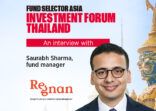The iShares MSCI Emerging Markets index has lost 16% of its value since mid-July. In the United States, both the Dow Jones industrial average and the Standard & Poor’s 500 index have both sunk nearly 11% since July 20.
With volatility in equities, interest rates and currencies being the new norm, uncertainty has increased, resulting in the mis-pricing of securities. These conditions create unlikely opportunities.
Amid this backdrop, Mark Laidlaw, senior research analyst at Morningstar, provides a comparative analysis of the Fidelity Asian Special Situations Fund and the J O Hambro Capital Management Asia ex-Japan Fund.
Investment strategy review
The Fidelity Asian Special Situations Fund draws heavily on an in-house bottom-up analysis. Saranjan Mukherjee, the portfolio manager, leans heavily on research when it comes to selecting stocks.
The fully-invested fund’s country and sector positioning tend to resemble the MSCI AC Far East ex-Japan benchmark, with its largest interests in Taiwan, China and South Korea.
In terms of stock preference, Mukherjee and the Fidelity analyst team like companies with rising or strong returns on equity, as well as names that they feel have been oversold on the market. The fund currently has 93 equities in its holding.
In contrast, the J O Hambro Capital Management Asia ex-Japan Fund, managed by Samir Mehta, shows a willingness to favour names that would be considered off the beaten track.
The fund’s core holding of 40 stocks makes up around 80% of its portfolio, while the remaining 20% is held in cash. At times, the fund’s cash holding move up to 25% to allow for greater flexibility. Mehta is benchmark-agnostic, which explains his unconstrained strategy, and he displays a noticeable bias towards telecoms, healthcare, gaming and consumer brands.
While both funds place a greater weighting on emerging countries, their regional focus is very different.
A snapshot of portfolio allocation, according to the fund fact sheets, on 31 July, 2015.
Fidelity fund |
J O Hambro fund |
|
| Launch | 3 October, 1994 | 30 September, 2011 |
| AUM | $1,279m | £298.10m ($452.70m) |
| Number of holdings | 93 | 40 |
| Top countries |
China – 26.80% |
India – 31.28% |
| Top sectors |
Financials – 28.20% |
IT – 19.18% |
| Top holdings |
Taiwan Semi Con – 5.02% |
Glenmark Phamaceuticals – 4.08% |
*Source: Fidelity, J O Hambro
Fund performance
The Fidelity fund’s index-aware approach means that the fund’s benchmark-relative performance will rest mainly on the ability of Mukherjee and his team to trade within boundaries. The fund’s result might not be a true reflection of their macro-economic and sector views.
Laidlaw noted that the fund is unlikely to perform well in extreme markets, either momentum or valued focused.
In J O Hambro’s case, the fund’s performance is very dependent on the dexterity of Mehta and his team. Given its heavy country and sector focus, one or two poor calls can severely damage the portfolio.
A look at calendar-year returns:
Year |
Fidelity (%) |
J O Hambro (%) |
| 2011 | -16.76 | – |
| 2012 | 17.67 | 19.83 |
| 2013 | 7.15 | 4.12 |
| 2014 | 6.22 | 14.25 |
| 08/2015 | -8.79 | -3.46 |
*Source: Morningstar
Commenting on the performance of the two funds, Laidlaw said that the Fidelity fund is suitable as a core holding of an investor’s total portfolio.
He noted that while J O Hambro has been regarded more as a supporting player, the fund has had a very impressive record; it delivered an annualised return of 14% since 2012, comfortably beating both the MSCI AC Asia ex-Japan Index and category peers.
|
|
Beta |
Volatility |
| Fidelity fund | 0.89 | 12.08 |
| JO Hambro fund | 0.73 | 12.24 |
| MSCI AC Far East ex-Japan | – | 13.10 |
| MSCI AC Asia ex-Japan | – | 13.08 |
*Source: Morningstar
Laidlaw pointed out that while the J O Hambro fund, at first glance, appears to be more volatile than the Fidelity fund, one has to remember that these two funds are compared against different benchmarks.
“[In this respect], the J O Hambro fund has actually been less volatile than its index while retaining the option to invest up to 25% in cash,” Laidlaw said.
In terms of catering to the different types of investor, Laidlaw noted that the J O Hambro fund allows investors to gain access into both India and China, and is particularly suitable for investors seeking to diversify into India.
“[The J O Hambro fund definitely] caters to an investor with a higher risk tolerance,” Laidlaw said.
















